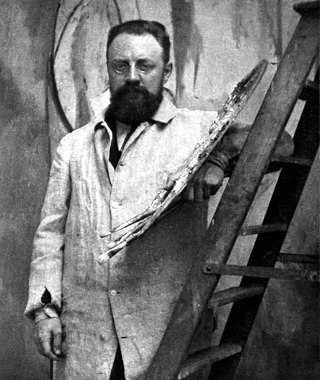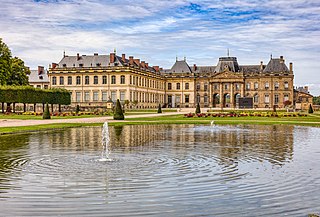
Henri Émile Benoît Matisse was a French visual artist, known for both his use of colour and his fluid and original draughtsmanship. He was a draughtsman, printmaker, and sculptor, but is known primarily as a painter.

Jean-Léon Gérôme was a French painter and sculptor in the style now known as academicism. His paintings were so widely reproduced that he was "arguably the world's most famous living artist by 1880." The range of his works includes historical paintings, Greek mythology, Orientalism, portraits, and other subjects. He is considered one of the most important painters from the academic period. He was also a teacher with a long list of students.

Lunéville is a commune in the northeastern French department of Meurthe-et-Moselle.

Jacques Joseph Tissot, better known as James Tissot, was a French painter, illustrator, and caricaturist. He was born to a drapery merchant and a milliner and decided to pursue a career in art at a young age, coming to incorporate elements of realism, early Impressionism, and academic art into his work. He is best known for a variety of genre paintings of contemporary European high society produced during the peak of his career, which focused on the people and women's fashion of the Belle Époque and Victorian England, but he would also explore many medieval, biblical, and Japoniste subjects throughout his life. His career included work as a caricaturist for Vanity Fair under the pseudonym of Coïdé.

Gabrielle Danièle Marguerite Andrée Girard, known by her stage name Danièle Delorme, was a French actress and film producer, famous for her roles in films directed by Marc Allégret, Julien Duvivier and Yves Robert.

The Palace of Lunéville is a residence of the Duke of Lorraine since the 13th century in Lunéville, about 35 kilometers east of Nancy, capital of Lorraine. The palace is owned by the Department Meurthe-et-Moselle since 2017. Many people visit the palace, park, or gardens of Lunéville every year, making it one of the most popular tourist attractions in the region.
Mildred Anne Butler was an Irish artist, who worked in watercolour and oil of landscape, genre and animal subjects. Butler was born and spent most of her life in Kilmurry, Thomastown, County Kilkenny and was associated with the Newlyn School of painters.

Alexis Simon Belle was a French portrait painter, known for his portraits of the French and Jacobite nobility. As a portrait artist, Belle's style followed that of his master François de Troy, Hyacinthe Rigaud, and Nicolas de Largillière. He was the master of the painter Jacques-André-Joseph-Camelot Aved (1702–1766).

The Henry II style was the chief artistic movement of the sixteenth century in France, part of Northern Mannerism. It came immediately after the High Renaissance and was largely the product of Italian influences. Francis I and his daughter-in-law, Catherine de' Medici, had imported to France a number of Italian artists from Raphael's workshop or former assistants of Michelangelo, known as the School of Fontainebleau, where many were based. Frenchmen were trained in the Mannerist idiom. Besides the work of Italians in France, many Frenchman picked up Italianisms while studying art in Italy during the middle of the century. The Henry II style, though named after Henry II of France, in fact lasted from about 1530 until 1590 under five French monarchs, their queens, and their mistresses.

Rosalie Filleul was a French pastellist and painter. She was born in Paris, and was concierge of the Château de la Muette. Although she initially supported the French Revolution, she nevertheless became disillusioned by its excesses and mourned the execution of Louis XVI. Somewhat indiscreetly, at the height of the Terror, she made arrangements to sell some of the furniture at the Château de la Muette to a secondhand dealer. This was reported to the authorities and she was arrested on charges of theft and concealment of biens nationaux – property belonging to the Republic. Rosalie Filleul was found guilty and guillotined in 1794, along with her friend Mme Chalgrin, despite the attempted intervention of Chalgrin's brother Carle Vernet.

Marguerite Gérard was a French painter and printmaker working in the Rococo style. She was the daughter of Marie Gilette and perfumer Claude Gérard. At eight years old, she became the sister-in-law of Jean-Honoré Fragonard, and when she was 14, she went to live with him. She was also the aunt of the artist Alexandre-Évariste Fragonard. Gérard became Fragonard's pupil in the mid-1770s and studied painting, drawing and printmaking under his tutelage. Gérard and Fragonard created nine etchings in 1778. Historians currently believe Gérard was the sole artist of five of these etchings, since many have a duplicate created by her tutor Fragonard. More than 300 genre paintings, 80 portraits, and several miniatures have been documented to Gérard. One of her paintings, The Clemency of Napoleon, was purchased by Napoleon in 1808.

Blanche Hoschedé Monet was a French painter who was both the stepdaughter and the daughter-in-law of Claude Monet.

Édouard Joseph Dantan was a French painter in the classical tradition. He was widely recognized and successful, even receiving grudging respect from a contemporary Modernist painter and critic Walter Sickert.

Georges Gasté is a French Orientalist painter and photographer.

Madame Georges Charpentier and Her Children is an 1878 oil on canvas painting by Pierre-Auguste Renoir. It depicts Marguerite Charpentier, a French salonist, art collector, and advocate of the Impressionists, and her children Georgette and Paul. The painting is held by the Metropolitan Museum of Art.















